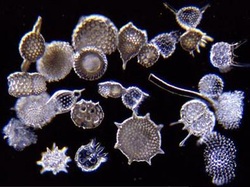Linda Guy
“Every age has it’s own image of the world. And every image reflects the vision of its time and of its maker.”
From: Proteus, a 19th Century Vision
Artist Statement: The Radiolaria Portfolio
This portfolio consists of ten 13 ½ x 20” digital and screenprints entitled The Radiolaria Series. These prints are based upon images of radiolaria or single celled animals found mostly at the equator drifting in ocean currents.
The first artist of note to study and draw Radiolaria was Earnst Haeckel, a contemporary of Darwin. In 1862, Haeckel published a series of prints in a book entitled Art Forms from the Ocean. The Art Deco movement influenced Haeckel resulting in prints that are precisely stylized. It is from his book of prints that I have virtually studied and re-drawn radiolaria.
My aim was to reintroduce some of Haeckel’s images changing them towards my understanding of art and science. In my drawings, radiolaria have an animated appearance consisting of conflicting forms and layers. Not only does this change Haeckel’s style but it also reflects a different understanding of science. In Haeckel’s time, a clear and linear path of thinking was prevalent but today we have learned to embrace a conflicting view of the physical world as evidenced by current physics.
From: Proteus, a 19th Century Vision
Artist Statement: The Radiolaria Portfolio
This portfolio consists of ten 13 ½ x 20” digital and screenprints entitled The Radiolaria Series. These prints are based upon images of radiolaria or single celled animals found mostly at the equator drifting in ocean currents.
The first artist of note to study and draw Radiolaria was Earnst Haeckel, a contemporary of Darwin. In 1862, Haeckel published a series of prints in a book entitled Art Forms from the Ocean. The Art Deco movement influenced Haeckel resulting in prints that are precisely stylized. It is from his book of prints that I have virtually studied and re-drawn radiolaria.
My aim was to reintroduce some of Haeckel’s images changing them towards my understanding of art and science. In my drawings, radiolaria have an animated appearance consisting of conflicting forms and layers. Not only does this change Haeckel’s style but it also reflects a different understanding of science. In Haeckel’s time, a clear and linear path of thinking was prevalent but today we have learned to embrace a conflicting view of the physical world as evidenced by current physics.




